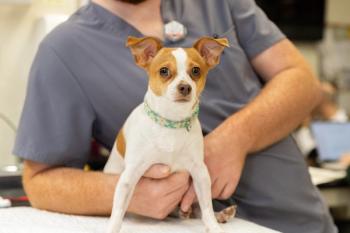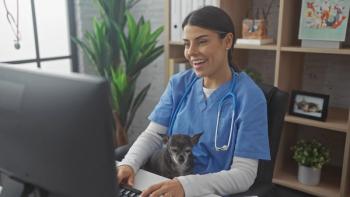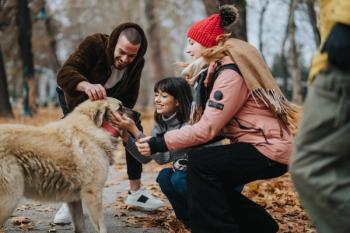
The frontline of equine care: AAEP On-Call veterinarians
A deep dive into the American Association of Equine Practitioners On-Call veterinarian program with 2 clinicians who are on the frontline.
The AAEP On-Call Program arose, at least partly, in response to tragedy. According to Sally Baker, AAEP Media Relations, “In response to the horse racing industry’s plea for accurate reporting of veterinary issues, particularly at the racetrack, the American Association of Equine Practitioners (AAEP) came to the forefront in 1991. Prompted by the tragic deaths of three horses during the telecast of the 1990 Breeders’ Cup at Belmont Park, the AAEP developed the On Call program to assist racetrack management with the media and live coverage of major races throughout the country.” The most tragic of those was the catastrophic injury of Go For Wand in the 1990 Breeders’ Cup Distaff at Belmont Park.
The AAEP On-Call program came to also include the Triple Crown and other major televised races, which became a critical portion of the reporting of the program in previous years. Notable examples include the catastrophic injury of Eight Belles, who pulled up after the Kentucky Derby on May 5, 2008, and Barbaro, who shattered his leg during the Preakness on May 20, 2006 (DVM360.com July 2006).
The AAEP On-Call program was present at the Del Mar Racecourse for the Breeders’ Cup from November 5 to 6, 2021, televised by NBC. This year, Scott Hay DVM, and Sara Langsam, VMD both of Teigland, Franklin and Brokken were the AAEP On-Call veterinarians at Del Mar. The Breeders’ Cup On-Call assignment is a relatively new thing for both Langsam and Hay. However, they both do a considerable number of On-Call assignments, Hay in South Florida, and Langsam at Belmont Park. “We’re both extremely experienced doing AAEP On-Call assignments,” stated Hay.
The purpose of AAEP On-Call Veterinarians
“The reason the AAEP On-Call Veterinary program was developed was to provide the media with some expertise as to things that were happening on the racetrack, whether it be an injury, report of a veterinary scratch of horse from a race, or an injury of a horse on the racetrack during racing,” stated Hay. “Previously, the program was initiated to liaison with the media of any kind of veterinary issues that might come up with horses that were participating during the many Breeders’ Cup events over the years. It began to ensure that appropriate information was given to the media as to occurrences of catastrophic injuries, other injuries, or issues that were veterinary-related so that the ‘message’ could be accurately portrayed on-air.”
“Hopefully they won’t need to reach out to us, and the races run safely without any incidents, injuries, or other veterinary issues,” emphasized Hay. “But, certainly in cases where we need to explain to the audience of an incident that might occur on the racetrack, or any other type of veterinary matters, then we will enable them to have us provide an accurate version that can be conveyed clearly to their viewing audience.”
“Certainly, injuries may happen,” cautioned Hay. “Our procedure as On-Call veterinarians are to feed information to the media. We do not practice on or treat the horses, and we don’t examine them. We get our information of what is happening on the racetrack from the attending veterinarian, and/or the regulatory veterinarian. If an injury occurs, whether on the racetrack or even on the backside, either the attending veterinarians, or the private practitioners that are taking care of these horses, treating, and resolving any veterinary issues. We get their assessment of the injury once the ‘working’ veterinarian stabilizes the horse. Once done, they get them back to a hospital facility or their own stall to provide further evaluation, and do further diagnostics before anything else is done. Once the horse’s veterinarian does what he/she needs to do, that message is conveyed by us to the media, so that we can provide them with accurate information and accurate updates as things change.”
The role of the On-Call veterinarians at the Breeders’ Cup at Del Mar is to function as the liaison between the veterinarians and the press, handling communications if there is an emergency or something of veterinary importance that needs to be reported the veterinary way. “The greatest portion of our On-Call duties is to be the point person, so the on-site veterinarians do not have to deal with the press and to relay accurate information to the television media,” stated Langsam.
“If there is a major incident, the racetrack veterinarians may make their own statements. But it is our responsibility within the On-Call program to gather the information from the veterinarians that are working on the racetrack and communicate an accurate effective image to the public about what is happening and what to expect. That is what the AAEP On-Call program is meant to do.”
Maintaining control of high-pressure situations
“Where we have large racehorses, traveling at high speeds, accidents and injuries unfortunately do or may happen,” emphasized Hay. “So, our role is to try to make sure that everybody gets the accurate information. That is our sole purpose—to assist on-air media in trying to convey the right message, so they can get the right message to their audience.”
“We all have our roles,” stated Hay. “We have to work on-the-fly because we don’t know what’s going to occur before it happens. We hope that nothing happens that we must talk to the media about. But when it does, we must work quickly to try to get the information from the people who are on the frontlines and get it in the right way to the media, so they can deal with it and get it across to their audience.”
Special situations, morning workouts, and prerace scratches
The On-Call veterinarians also work in the mornings as the horses are working out.
“We’re mostly there for the press,” stated Langsam. “We are not doing the morning veterinary exams or other veterinary duties that take place prior to the races. However, we will interact with the veterinary teams, the racetrack veterinarians as necessary to liaison with the media. We are there so that everyone is comfortable with communicating with the press if something untoward happens in the afternoons during the races, and to get the most accurate information from the working veterinarians to everyone else.”
“I know that during the Breeders’ Cup, we’ll be out there a couple of days early, and be able to see the horses training, though our role is minimal at that time,” repeated Hay. “But, if there is a story developing about a particular horse, possibly a horse that is ill, or slightly injured that horse is going to be scratched.” This occurred just a few days prior to the Breeders’ Cup races, as Jack Christopher, a leading entrant for the Breeders’ Cup Juvenile, had a slight filling in his lower leg and was scratched. “Or a horse that is not training appropriately and maybe the trainer or owners are looking to scratch the horse. This occurred with United, who was to run in the Breeders’ Cup Turf, as his trainer was concerned with exactly that. And those sorts of stories/incidents that we need to talk to the media about, getting that type of information from the team of Breeders’ Cup regulatory or attending veterinarians. Talking to them and getting those appropriate background stories, just in case we’re asked that about them by the media. That is an important portion of our On-Call role.”
The AAEP On-Call Veterinarians also interact with the California Horse Racing Board (CHRB). “Dr. Jeff Blea is the Chief Medical Officer of the CHRB, so we’ll interact quite a bit about any incidents he sees as relevant,” stated Hay.
“There are all kinds of preparation amongst every person that plays a role during the races and on the backside—whether it be the Breeders’ Cup staff, the Del Mar staff, the Del Mar racing stewards, or the racetrack attending and regulatory veterinarians. All these individuals along with the media spend a lot of time of background preparation for this major event so that it goes as smoothly and cleanly as possible.”
The On-Call program also got involved with the Breeders’ Cup “Win and You’re In” broadcasts, representing some of the nationally NBC-broadcasted or by other media-broadcasted races.
So, if they were involved with those races, the On-Call program was mostly to assist the television media, and therefore they provided an On-Call veterinarian depending on where their On-Call members were located. “Dr. Kathy Anderson was On-Call in the Mid-Atlantic area while I was covering at Belmont Park,” said Langsam. “Dr. Hay was covering Gulfstream, while our other partner, Dr. Luis Castro was covering the Saratoga meet.”
“With the Breeders’ Cup if something untoward happens during the week while horses are training or if a horse becomes ill, we may get involved though our obligations are primarily during the telecast,” said Langsam. “Not necessarily before or after, though with social media, sometimes I’ve been asked if something happens, I’ll quickly take care of a follow-up question.”
“During the 2 race days, we will also be responsible for On-Call duties during the undercard races as well,” Langsam related. “So, for both day’s full cards, we will be available to the press for any questions or dealing with anything that comes up. We’re there to interpret what may occur during the two days of actual Breeders’ Cup racing events, not much before.”
“As I do work as the NYRA On-Call veterinarian, I’m well aware of what I need to do,” Langsam remarked.
“When something happens on the racetrack, if it’s not catastrophic, there are a lot of unknowns,” Langsam emphasized. “But I usually tell people what the next steps are and some basic information that I’m getting relayed from the track veterinarians that are looking at the horse so that there is an effective and as precise communication via the media to the concerned public. Then, I field any other questions relating to the potential injury and/or the horse’s general prognosis.”
“If needed, Del Mar has a nearby veterinary hospital, with full options for horse care, fully staffed with the necessary veterinary equipment to deal with serious injuries, including surgical equipment and staff,” Langsam said. “Dr Ryan Carpenter will be at Del Mar to be available for any potential equine outcome, emergency, or one that requires surgery. The On-Call veterinarians would be then available to liaison between those veterinarians that are treating the horses and to relay that information to the press. We are not doing any actual veterinary duties, though we’re media trained and prepared to get the television media as much detailed information as we can and keep the concerned public informed about what is occurring. Because the veterinarians who are working on the horses do not have time to do what we are doing, we’re there to help them convey information to the press.”
“After each race is cleared and all the horses come back well, we’re done,” stated Langsam. “And, of course, once the broadcast ends, we’re done.”
“Hopefully, we won’t have to be involved if all goes safely, but that seems to not always happen. My hope is that we’ll be able to relax, enjoying the Breeders’ Cup races, and hopefully not have to play our AAEP On-Call role,” concluded Langsam.
Newsletter
From exam room tips to practice management insights, get trusted veterinary news delivered straight to your inbox—subscribe to dvm360.





